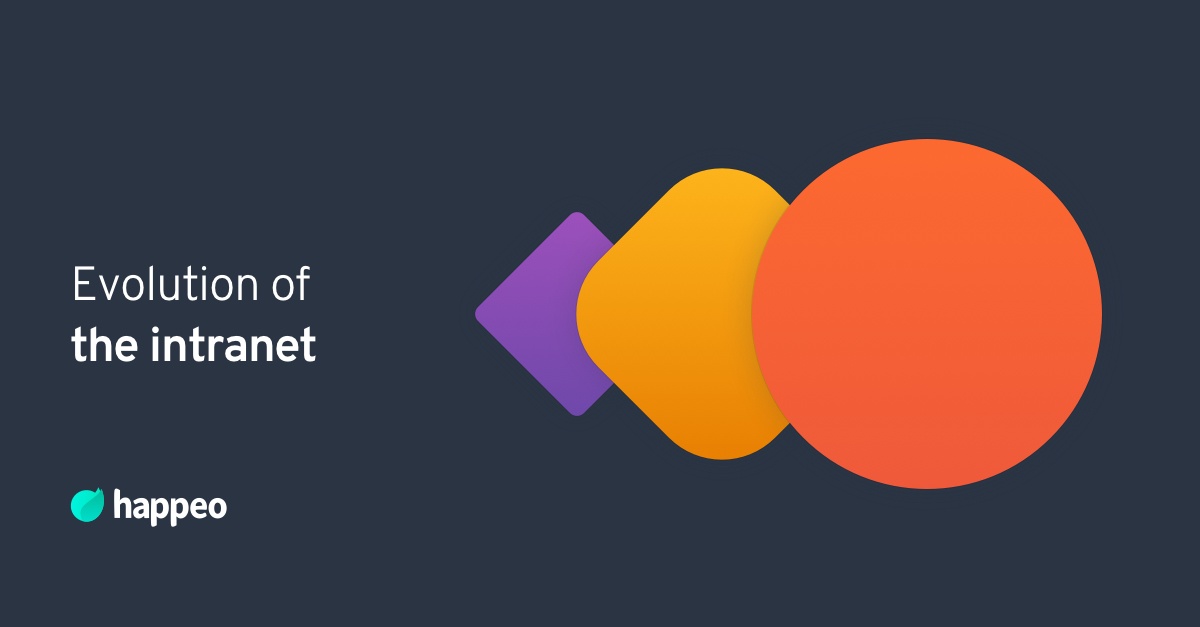

5 stages of the intranet software evolution

Jonathan Davies

See how an intranet works
Learn how an intranet works with this short video.
Table of Contents
- The 5 stages of intranet evolution:
- The early beginnings: Internal Communication and information
- Developments in intranet technology: collaboration and social intranet software
- Digital Workspace: Intranet 2.0 and how we got here
- Intranet 2.0 or Social Intranet software
- Intranet today: internet tools or intranet solutions
10 mins read
Wed, Dec 5, '18
Intranet platforms can be an intuitive solution for collaboration, content management and more.
Intranet software has become easy to use and roll out, since third-party cloud-based providers greatly simplified the intranet implementation process.
It wasn’t always this way. The evolution of intranet systems has been decades in the making, and the initial business intranet software were not the user-friendly solutions they are today. So where did intranets come from, and how did we get to where we are today?
The 5 stages of intranet evolution:
- Internal Communication and Information (pre and early internet stage)
- Work Tools and Applications (internet integration)
- Collaboration and Groupware
- Social Intranet software
- Digital Workspace (Intranet 2.0)
The early beginnings: Internal Communication and information
The beginning of intranet-like systems can be traced back to the sixties, even before the emergence of the world wide web. Functions like chat, messaging, forums, and email were available within a confined space and group. Because this was groundbreaking technology, it remained fairly exclusive, hindering mass-adoption.
In the late eighties came the development of the Ethernet, which was another step along the intranet road. Ethernets provided a Local Area Network (LAN) solution for collaborative working, but the management of this network was still expensive and unreasonable for the everyday business.
It wasn’t until 1994 when the term “intranet” was first coined. This term coincided with the emergence of the internet in an attempt to create an internet-web system for a defined and limited group. While the group definition of the intranet was an important factor, the main goal of the intranet was business-minded, specifically it was meant to increase employee productivity through easier access to documents and more effective communication. That main goal has stuck through the evolution process of the business intranet software – an employee-centered system that boosts productivity and creates an outlet for easy communication across the enterprise.
Breakthroughs in intranet software and technology: late 90s
1996 caused a shift in this expensive, almost-elitist solution, with the release of “Intranet Genie”. Intranet Genie was a product constructed by Frontier Technologies, and it was the first intranet-type software specifically geared toward employee communication and collaboration. It featured applications for document sharing, messaging, and more. This is the first real step that evolved business intranet software evolved from the traditional top-down structure to a more horizontal, interactive platform.
While “Intranet Genie” was a breakthrough for intranet software, it was an actual software bundle that needed to be installed through a server rendered it easy to become outdated; especially with the rise of the internet on the horizon. Around the same time, information search engines came on the scene in the world wide web. Blogger Tomasz Sobczak states in his article on Findwise:
"Equipped with a search engine, an intranet has become an invaluable working tool practically in all sectors, especially in specific departments as customer service or administration."
When adopted into an intranet system, suddenly there was a way to search through all of the content stored on the server. You could finally find what you needed. But, with new developments come new challenges and hardships. While everyone recognized the need for search engine-functionality, employees became frustrated by poorly structured search engines that generated irrelevant results within the intranet.
Intranet adoption in the early 2000s: work tools and applications
Although the idea of an intranet was first formed in the mid-nineties, it took multiple years for it to actually be adopted by the larger corporate world. As it started to take off, businesses started to become accustomed to the norms of use. The first developers of intranets realized that intranet software needed to support the main functions of the business, staff had to be able to maintain it, and it needed to be user-led. So even in the early stages, the same uses and guidelines we see today were established.
Unfortunately, the potential benefits of intranet software were not actually realized at first. Although the rise of the internet helped to launch the intranet as well, the content found on the world wide web was usually more relevant to employees than that of the intranet. The first intranets were little more than a static browsing web page where information would be funneled down from management to the general employee population. There was virtually no intranet adoption process, because there were no practices to really adopt. There was also a lot of hardware and complicated software, which led to more needs within the enterprise than the installation was actually worth.
Business intranet software of the past used complicated, external servers connected through a LAN to support the network. So, in order to implement an intranet system, you needed to purchase or build this hardware, install it, and maintain it. This is why intranets were really only beneficial and plausible for major enterprises. Intranet systems could only be supported by the corporations that had the time, money, and management team to maintain this complex hardware.
As intranets started to become more relevant, the California-based Neilsen Norman group began developing its first guidelines for the future Intranet Design Award reports, which has been - and continues to be - the leading productivity and statistics evaluator for intranet solutions.
Early examples as the intranet evolved
For example, Jive Software was founded in 2001 as a platform for communication and collaboration solutions for businesses. In its beginnings, Jive served solely as a forum platform.
Although Jive attempted to evolve its intranet solution with the times, mainly by business intranet software integration and social media incorporation, in the intranet world it still remains old-fashioned and traditional. Many previous clients of Jive are looking for a more modernized, integrated, social platform that we are currently seeing trending in intranet solutions.
Similarly, Microsoft released SharePoint in 2001 and it was not widely adopted. Its main purpose back-in-the-day was to store documents and data, and that was about the extent of it. But, as technology and the intranet developed, so did Microsoft. In 2003, they released a new version of Sharepoint that included a way to integrate team websites into a larger, corporate portal.
Then in 2007, Microsoft continued the integration trend with a platform to publish websites incorporated into the intranet software. After adding that adoption feature, their intranet adoption rate increased by about 50%. But, SharePoint still has a long way to go. The recent updates of the intranet software have been reported by many enterprises to have usability issues, which has caused Microsoft to put a lot of time and energy into revamping it.
While these early intranet examples pioneered the field in the best way they could, the fact that they were created in the days before Intranet 2.0 puts them at somewhat of a disadvantage. They seem to be stuck in the traditional mindset of intranet functions and need to continue to reinvent themselves to stay relevant with the times and drive the intranet adoption process.
Developments in intranet technology: collaboration and social intranet software
The mid-2000s brought us the rise of social media, an internet revolution that would change the way we relate and communicate as people. Business intranet software began to evolve and move away from simple chat-centered communications into full web-page profiles and platforms that took social internet interaction to a new level. MySpace and Xanga were popular in the early millenium, until Facebook came on the scene in 2008 and overtook both platforms in popularity.
Meanwhile, as social media was on the rise, intranet software had not caught up with this trend. At this point, the intranet had evolved from a simple, static web page. No longer was it only meant to deliver and store information on a platform. It gained more structured project and document management tools with the incorporation of features such as calendars and task list tools. The next leap to really advance itself to employee engagement was the adoption of the social intranet.
The first steps of intranet socialization started when enterprises realized that collaboration creates efficiency. We then saw an increase in collaboration tools which allowed employees to share and work on documents simultaneously. Intranet software functions shifted; corporations became aware that socialization in their internal workspace would allow employees to not only work together, but to truly connect with each other.
In 2008, Jeremiah Owyang commented on the rising socialization of intranets, stating that with this movement, “the social capital of a company (the contacts and influence within a company) starts to become realized and the need to share contacts, knowledge across the enterprise, regardless of location or team, starts to emerge.”
With social intranet software on the horizon, employee engagement within the intranet became went from a trend to a movement. Socialization features allowed employees to interact with each other through the medium of the intranet. This suddenly made the intranet a relevant tool for the entire workforce. The Nielsen Norman Group found that integrating social features in intranet solutions are “essential for supporting employee collaboration and knowledge management.” The reason it is so essential is that you will find “people contributing to intranet content on a daily basis, through blogs, comments, ‘Likes’, ‘Shares’ and status updates.”
With more people contributing, the likelihood of relevant content and up-to-date information in intranet solutions increased. No longer was it a few people from the top sending down data to the masses, but instead it was becoming a collaborative effort of an entire team reflected in one platform.
The Software as a Service (SaaS) movement
The 2000s also saw a rise in SaaS usage, starting with Salesforce. It was the first built-from-scratch SaaS that quickly became popular in the tech world. What was so revolutionary about Salesforce was its “no software” platform; service and installation were provided purely over the internet. Salesforce’s beginnings offered solutions such as a Customer Relationship Management (CRM) system, cloud-based services, its Force.com platform, Chatter, app integration, configuration, and web services.
Salesforce also helped drive SaaS sales through technological developments. It evolved and moved with the times to pave the way for more SaaS tools to come on the scene. With this successful model to follow, companies from all corners of the tech industry jumped on their chance to reinvent themselves. SaaS solutions became available for collaboration, social networking, customer service, CRM, human resources, management, software development, analytics, and more.
SaaS broke us free from the chains of physical hardware installation and launched us into the digital, cloud-based solution age.
Digital Workspace: Intranet 2.0 and how we got here
The epiphany of socializing the intranet, along with cloud-based solutions on the rise, cleared a perfect path for a modernized, revamped intranet system.
So what are the features that brings an intranet solution to the “2.0” status? Let’s look back at the intranet evolution process to see the shift in the direction of intranet software.
Evolution of the intranet pre-2.0
1990s:
Basic intranet systems emerge. Consist of static, top-down communication and essential company information. At the time it’s only feasible for large corporations with access to resources.
Enter Intranet Genie and search engines
Early 2000s:
Companies make attempts at creating more viable, accessible intranet software with a more collaborative aim, but cumbersome servers and lack of employee engagement hindered widespread intranet adoption.
Enter social media platforms and SaaS
Late 2000s:
The introduction of social media platforms and communication tools caught the attention of society, and the collective workplace realized it could capitalize on the social aspect of corporate offices to increase productivity. That, coupled with the move away from the expensive, complicated hardware it previously took to run an intranet system, made intranets accessible for companies and desirable for employees.
Intranet 2.0 or Social Intranet software
Social features elevated intranet to its 2.0 inception. Up to this point, you see features like employee directories, help desks, simple app integrations, and even a sense of enterprise identity within the intranet solution. However, the start of Intranet 2.0 is marked by those early social media integrations – starting with blogs and discussion forums.
Realistically, most enterprises are just on the cusp of incorporating intranet 2.0. Most are still stuck in the traditional, ineffective intranets of the past because they haven’t figured out that this social piece is crucial for employee engagement and productivity.
And from those simple socialization elements comes the launch of complete social media integration, complete with user profiles for each employee, activity streams, and reaction features. Your employees can easily create user-generated content, making everything more interactive and relevant. The more sophisticated social software is, the more employee engagement you will see, leading to better intranet adoption, increased productivity, and better Return on Investment (ROI).
Intranet today: internet tools or intranet solutions
The other crucial piece to modern intranet systems is integration. Remember those SaaS tools? Many enterprises adopted the use of SaaS collaboration and productivity tools while intranet solutions were still stuck in the pre-2.0 phase. This means companies already had intranet software they had implemented company-wide, and it was working for them. The next logical step to creating a holistic intranet solution was the incorporation of those relevant SaaS tools into the larger intranet system.
The most advanced intranet software today provides integration with collaboration tools such as Google Workspace (formerly G Suite) and Microsoft 365. This means you can take the tools you are already using and incorporate them into a company-wide platform for complete digital integration and cooperation.
There are a lot of enterprises today that rely on SaaS tools only for their collaboration and communication platforms, and while this does work, integrating them into an intranet solution is the only way to break down communication silos. SaaS tools often exist in isolation of each other, causing information or communication to fall between the cracks of the separate platforms. Integrating SaaS tools into intranet software means employees only need to go to one platform, one place for everything they need to get the job done.
For example, you could have a SaaS tool for communication, another for project task management, and then use Google Workspace for document collaboration and storage. When using multiple tools, there is bound to be overlap or gaps in content. Also, employees are forced to log in to different platforms throughout the day, which decreases productivity. Information gets lost in the sea of different tools, leaving employees frustrated and confused.
That brings us to one solution: the digital workplace. The modern-day business intranet software that is fully integrated with collaboration SaaS tools, user-minded and focused with extensive social networking platforms and user-generated content, hosted through the cloud so there is no need for local servers, bringing everything your employees need in one centralized hub that can be accessed from anywhere. The intranet adoption process is made easy through these features, functions and User Experience (UX) design, which will keep your employees coming back to your intranet platform. This is the type of intranet that enterprises need today, and it will soon become necessary if your company wants to remain relevant in this ever-changing technological world.
The intranet Renaissance
Intranets have come a long way since their current-day digital-workplace format. Although a decade ago many enterprises would have sentenced the intranet as a dying, obsolete solution, we are now experiencing an intranet renaissance.
The functions of past business intranet software have paved the way for what we are seeing today, which is an all-inclusive digital workplace that provides employees with everything they need to get their jobs done. It capitalizes on your human resources by connecting employees through social media, allows them to collaborate and create content, and uses the latest technology to keep your enterprise at the frontlines of the digital age. With the focus now shifted from supporting the management of the company to supporting the entire workforce, the intranet is going to continue to evolve and revolutionize the way we work for decades to come.





